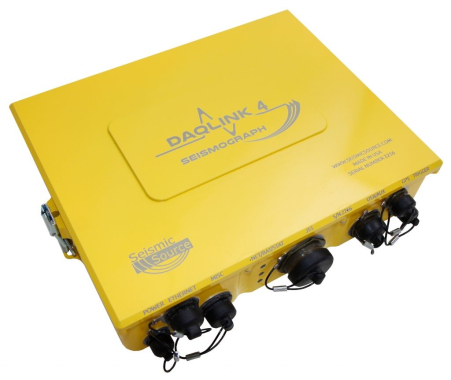DAQlink 5 seismograph for surveys and monitoring
DAQlink-5 is a portable inline seismic seismograph that provides seismic surveys with any methods on land, in boreholes and in the water area. The possibility of continuous data recording allows using the seismograph as a stand-alone recording system for seismic monitoring or passive MASW.
The number of channels in one recorder could be 6, 12, 24 or 48, but the system configuration allows increasing their number by linking the seismographs through cable lines up to 3 km long, which are used for time synchronization in the modules and data exchange between them. When using the seismograph as a stand-alone recorder, time synchronization of the units is carried out through a GPS receiver, and in the case of operation in mines and tunnels it is maintained through a built-in clock or with the help of a VHF radio modem.
- Ability to link seismographs in a single array using twisted-pair cable (length up to 3 km), Ethernet, Wi-Fi or GSM modems
- Any recording duration up to continuous recording
- Wide bandwidth of the recorded signal: 0 to 20,000 Hz
- Capable of remote control, setup, registration and data downloading via Wi-Fi, Gigabit Ethernet or cellular connection. Built-in FTP server
- VHF / UHF radio or twisted pair wired synchronization (up to 3km) for use in mines
- Continuous recording with GPS time synchronization
- Multiple trigger options for recording: by source trigger sensor signal, LTA (Long Term Average) and STA (Short Term Average) event, TTL pulse and others. Even email notification if an expected LTA or STA event is detected
- Data registration for all kinds of sources. Supports Force 3 controllers
- Built-in 16 GB memory for stand-alone data recording and flash drive connection for data backup and transfer
- Built-in tools for testing seismographs (distortion factor, mutual interference between the channels, phase suppression, inherent noise level) and geophones (impedance, frequency, attenuation, sensitivity)
- Data can be stored in the formats SEG-2, SEG-D, SEG-Y, ASCII or MiniSEED
Several seismographs can be linked together into a single recording array using different wired or wireless interfaces. There are so many ways to connect that only a few of them are listed here.
Several DAQLink 5 can also work in a fully stand-alone mode without a network connection or connected computers. The data are recorded on the built-in memory of GPS-synchronized seismographs and can be downloaded after the work is completed. CSP seismograms are created later using the Harvest software.
The side placement of the connectors is convenient for linking the seismographs into a single array.
- Seismic cables
- Seismic receivers
- Sources
- Synchronization systems
- Computer software
|
Number of channels in one station |
6, 12, 24, or 48 |
|
ADC capacity |
24, Σ-Δ bits |
|
Dynamic range |
124 dB (@ 500 Hz) |
|
Preamplifier gain |
×1 (0 dB), ×4 (12 dB), ×16 (24 dB) |
|
Sample rate |
125; 250; 500; 1000; 2000; 4000; 8000; 16000; 32000; 64000 Hz |
|
Frequency range |
0 ÷ 20 000 Hz |
|
Anti-aliasing filter |
85% of Nyquist frequency |
|
High Pass Filter |
0.001 ÷ 120 Hz, adjustable |
|
Filter type |
linear-phase |
|
Trigger accuracy |
±1 (@ 500 Hz) μs |
|
Maximum input signal with minimum gain |
±3.7 V |
|
The level of inherent noise of the registering channel |
< 0.2 µV (@ 500 Hz) |
|
Non-linear distortion coefficient |
0.00008 % (@ 500 Hz) |
|
Mutual interference between channels |
-125 dB |
|
Common mode suppression factor |
100 dB (@ 500 Hz) |
|
Power consumption |
0.13 W/channel |
|
Input impedance |
100 kOhm |
|
Time synchronization |
GNSS receiver or VHF radio |
|
Data storage capacity (16 Gb CF internal memory) |
120 hours (24 channels @ 500 Hz, 16 Gb) |
|
Maximum external memory capacity (Ethernet or USB) |
unlimited |
|
Data format |
SEG-2, SEG-D, SEG-Y, ASCII, MiniSEED |
|
LEDs |
Ethernet, battery status, and operating mode |
|
Power |
10 – 28 V DC |
|
Temperature range |
-40 ÷ +85 °C |
|
Operating humidity |
0 ÷ 100 % |
|
Dimensions |
245х340х75 mm |
|
Weight |
3.135 kg |
























